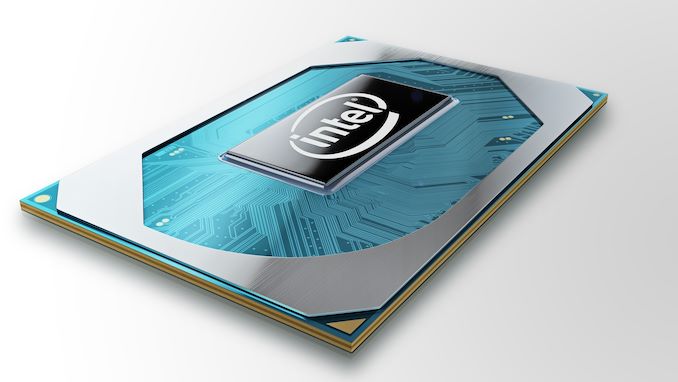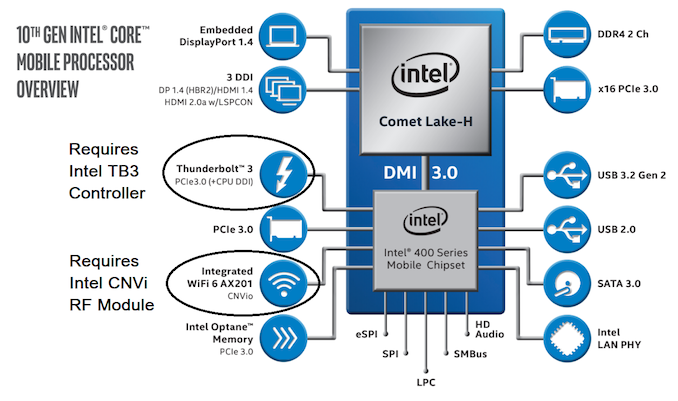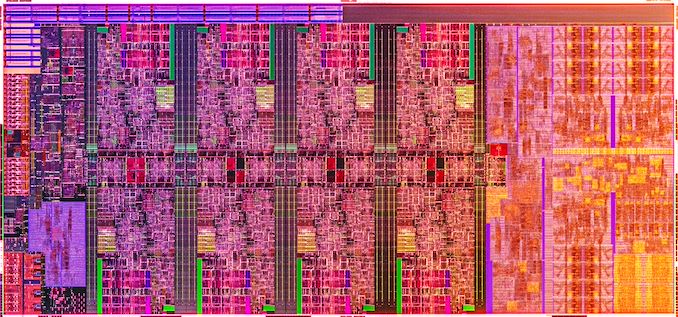Intel Details 10th Gen Comet Lake-H for 45 W Notebooks: Up to 5.3 GHz*
by Dr. Ian Cutress on April 2, 2020 3:01 AM EST
Two of the big announcements out of CES this year were both mobile related: Intel and AMD announced they would be launching new gaming laptop processors into the market in the first half of this year. 45 W parts, also known as H-series in the business, provide the basis for productivity and gaming notebooks that use additional graphics to give some oomph. These systems span from thin and light with GPU requirements, through ‘luggables’ that are just about portable, all the way up to desktop replacement designs. Intel’s newest 10th Gen H-Series are based on the Comet Lake family, the fifth iteration of Intel’s 14nm Skylake designs, and they’re going all the way up to 5.3 GHz*.
The new CPU list from Intel starts with the Core i9-10980HK at the top, with eight cores, sixteen threads, and all the focus is on that 5.3 GHz turbo frequency.
*This CPU can hit this frequency on two cores. However this has some specific requirements: the system needs to be within its secondary power limits, and Intel’s Thermal Velocity Boost also needs to be turned on. The latter of which means that there has to be additional thermal headroom in the system, and that OEMs have designed for this and enabled it within the system. This allows the CPU to go from 5.1 GHz to 5.3 GHz. Every Intel Thermal Velocity Boost enabled CPU requires specific OEM support in order to get those extra two bins on the single core frequency.
The base frequency of this chip is 2.4 GHz, and it has a regular 45 W TDP (sustained power), which can be run in cTDP up mode for 65 W. Two other plus points on this chip is that it is unlocked, for when an OEM provides more thermal headroom, and it supports DDR4-2933, which is an upgrade over the previous generation. Intel's recommended PL2 (turbo power) for the Core i9 is 135 W, and Intel says the recommended 'Tau' is set to 56 seconds for the i9, and 28 seconds for all the other CPUs. OEMs don't often adhere to these values for notebooks, but they are provided as a guide. It does mean that in order to hit 5.3 GHz, the Core i9 is by default allowed to take 135 W across two cores, or 67.5 W per core. Even at 60W per core, you're looking at 50A of current per core... in a laptop.
| Intel 10th Gen Core 45W Processors (Comet Lake-H) |
|||||||
| AnandTech | Cores Threads |
Base Freq |
Turbo Freq*1 |
Turbo Freq*2 |
DDR4 | TDP | cTDP Up |
| i9-10980HK ++ | 8 / 16 | 2.4 | 5.1 | 5.3 | 2933 | 45 W | 65 W |
| i7-10875H | 8 / 16 | 2.3 | 4.9 | 5.1 | 2933 | 45 W | - |
| i7-10850H + | 6 / 12 | 2.7 | 4.9 | 5.1 | 2933 | 45 W | - |
| i7-10750H | 6 / 12 | 2.6 | 4.8 | 5.0 | 2933 | 45 W | - |
| i5-10400H | 4 / 8 | 2.6 | 4.6 | - | 2933 | 45 W | - |
| i5-10300H | 4 / 8 | 2.5 | 4.5 | - | 2933 | 45 W | - |
| *1 Turbo Frequency for devices without Thermal Velocity Boost *2 Turbo Frequency for devices with Turbo Max 3.0 and Thermal Velocity Boost ++ Unlocked CPU + Partial Unlock |
|||||||
Intel only has a single Core i9 at the top, with the top grade i7 also getting 8 cores, but only up to 5.1 GHz and no overclocking. The Core i7-10850H is going to be the second exciting part over the i9, with six cores and a 5.1 GHz turbo, but it allows an additional 4-bin overclock on the first two cores where thermals allow. All of the CPUs here are listed as 45 W, and all support DDR4-2933 memory (up to 128 GB we believe). Due to Intel Thermal Velocity Boost, all the i7 and i9 parts are +200 MHz above what they would be without the technology, with frequencies that we are more used to seeing on the 9th Generation.
Intel states that there will be 30+ designs using the new 10th Gen Comet Lake-H that fit within the ‘thin and light’ profile of 20mm, and 100+ designs in total across consumer, commercial and workstation. Intel is keen to highlight that it is the only CPU vendor that has OEM partners that provide HDR1000 panels and 300 Hz refresh displays in this market.
Intel also made a big fuss about TB3 support, although it isn’t native here – you still require a controller. One positive for 10th Gen is that it supports two TB3 controllers, rather than previous generations that only supported one. Though again, it depends on whether the OEM puts it in their system, because it isn’t native to the CPU.
We’re not going to post Intel’s benchmarks here, because to be quite honest they are not comparable. In gaming tests, Intel compares a 10980HK equipped with a RTX 2080 Super to a 7820HK equipped with a GTX 1080. As a result, a lot of difference in the gaming performance is going to be in the GPU, but also the graphs that they showed did not start at zero – suggesting that the graph somehow doubled despite only rising 44% in a select test. We’re going to wait to see for ourselves what the hardware can do.
Intel did show a die shot of the silicon, with all of its eight cores. It looks strikingly similar to the Coffee Lake 8-core silicon, because it’s practically identical. If there are any changes, it is minor, and then the chip is binned for the voltage profile.
Meanwhile, although none of Intel’s partners were named or otherwise involved in Intel's own announcement, they have been holding separate briefings regarding their laptop plans. MSI, Lenovo, Acer, and others are all releasing 10th Gen laptops as soon as April 15th, with the rest to follow in May. Broadly speaking, expect to see many vendors update existing 9th Gen gaming systems to include 10th Generation parts, though in the case of gaming laptops we're going to see the occasional, more substantial update to take advantage of NVIDIA's new hardware and thermal capabilities.
Intel’s competition here is going to be the recently launched Ryzen Mobile 4000 processors, in devices like the ASUS Zephyrus G14 and the Dell G5 SE. These new APUs were launched on 1st April, however unfortunately we were not told of an embargo change, and still expected the launch to be another two weeks later. We’re aiming to get our review out next week. When we get access to Intel’s 10th Gen H-series, we will compare it against AMD as well.














157 Comments
View All Comments
vladx - Friday, April 3, 2020 - link
As a tech enthusiast and software engineer, I will continue to buy Intel over AMD until AMD fires whoever is in charge of the disaster called software division and also replaces GUI designers with actual competent programmers.Zizo007 - Friday, April 3, 2020 - link
Which CPU software??I have a Ryzen with an OCed 2080 Ti and was never happier. I had AMD gpus before and never had software issues. What you're talking about is the 5700XT software issues because its a new gpu. They're solved long time ago.
Nvidia software sucks, sluggish and looks like Win XP. Very bad.
Zizo007 - Friday, April 3, 2020 - link
AMD software is faster and more modern and had less bugs. My nvidia control panel doesn't reset settings when I click reset. Idle clocks are high until I reinstall the whole driver and control panel.TheinsanegamerN - Saturday, April 4, 2020 - link
It has less bugs, thats why the number of bugs in AMD drivers became such an issue that tech forums and reviewers started writing stories about how many customers were returning Navi GPUs in favor of Nvidia RTX cards and how the problems had been going on for 6 months and the problems were now boiling over?Your nvidia driver has bugs? Have you gone through DDU and a system wipe that AMD owners seem to think is a legitimate way to fix driver bugs? In fact, if AMD has such good software....why do you have an Nvidia card anyway?
Qasar - Saturday, April 4, 2020 - link
i actually went through a complete wipe of my comp, and reinstalled windows to see if i could fix the issue i had with nvidia's drivers, and guess what, still wasnt fixed till a few driver releases from nvidia later. havent had to go to that extreme with my 7970 way back when before i replaced it with the 1060 i now have.schujj07 - Friday, April 3, 2020 - link
Translation: I will put in random credentials to make my post look more relevant, but I don't have any actual experience using anything but Intel & nVidia since they can do no wrong.Silma - Thursday, April 2, 2020 - link
So basically we are back to the pentium, there is absolutely no improvement in process or else, and Intel is just giving you the right to consume exponentially more power for a few percents at most of increased speed, leaving you with no battery autonomy and a hot and loud system.I seriously hope the 45W AMD are good and that Apple will produce Non-intel Macs.
Intel really needs a painful wake-up call.
It's time to forget 14 nm, and it's already time to forget 10 nm.
psyclist80 - Thursday, April 2, 2020 - link
We are back to the Pentium 4 days aka NetBurst. Pentium 3 was greatJust waiting for the Extreme Editions to show up! Seems they didnt learn the first time.
SolarBear28 - Thursday, April 2, 2020 - link
Ultrabookreview tested an Asus Tuf A15 with Ryzen 7 4800H. It's faster than Core i9-9880H on repeated cinebench R15 runs while consuming 10% less CPU power.eastcoast_pete - Thursday, April 2, 2020 - link
Unless Intel a. includes AVX512 in most/all of those chips and b. pushes software publishers with all might to use AVX512 whenever it could even remotely make sense, they're toast. Outside that, the Ryzen 4000 chips are far better value for the money.The other thing that could also prevent AMD from taking a huge portion of the mobile PC market is if manufacturing capacity and pricing keep the 4000 series mobile Ryzen back. I am set to buy a new laptop this year, and unless unforeseen changes occur, it'll be Intel outside this time!